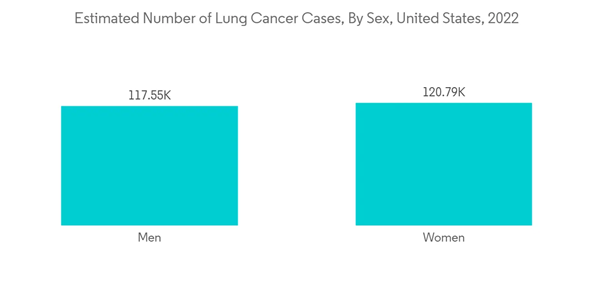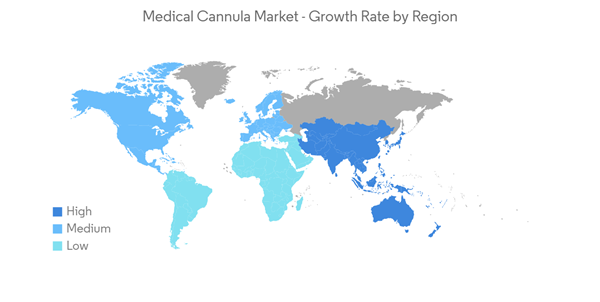At the start of the pandemic, the health care system was severely affected by things like surgeries being canceled, appointments being late, and long wait times.The surgeries were put off, and the number of surgeries went down, which had a big effect on how fast the medical cannula market grew.For example, a study published in December 2021 in PubMed found that the number of surgeries and other elective procedures in the US dropped by 48% during the first shutdown compared to the same time period after the pandemic.This decline in surgical procedures notably impacted the demand for medical cannulas. However, as hospital admissions of chronic disease patients increased in the later stages of the pandemic, the market studied is likely to grow.
The main things that drive the studied market are things like the growing number of patients, the growing number of surgeries and minimally invasive procedures, and the growing number of technological advances.For instance, as per the AIHW Elective Surgery Activity Report, the number of patients for elective surgeries added in 2020-21 (893,200) was a 6.6% increase from the previous year. Hence, an increase in the number of surgeries is likely to create a demand for medical cannulas used during surgeries, thereby contributing to market growth.
Also, the market is likely to grow because of improvements in technology and research studies that show how the medical cannula can be useful in different situations. For instance, as per the article published in October 2022 in ScienceDirect, the study showed the implantation and support for terminal heart failure in pediatric patients using the Berlin Heart EXCOR Venous Cannula. Because of this, these kinds of research studies and case presentations are likely to increase the demand for medical cannulas and help the market grow.
Also, microcannulas make it easier to remove more fat during cosmetic surgeries, so they are used a lot in plastic surgery and cosmetic surgery.As the target population around the world became more interested in how they looked, so did the demand for cosmetic and plastic surgery.For example, the ISAPS report, which came out in January 2022, said that breast augmentation (1,624,281), liposuction (1,525,197), eyelid surgery (1,225,540), rhinoplasty (852,554), and abdominoplasty (765,248) were the top 5 cosmetic surgeries done around the world in 2020.Cannulas used in aesthetic procedures are likely to become more popular because there are so many surgeries in the field of aesthetics.
Due to the rise in surgical procedures and the number of studies showing the benefits of medical cannulas, the market is expected to grow at a healthy rate over the next few years. However, the risk of injury to the nerves and other complications due to improper stabilization of the cannula is predicted to hinder market demand.
Medical Cannula Market Trends
Nasal Cannula Segment is Expected to Witness a Significant Growth in the Market Over the Forecast Period
A nasal cannula is a device that helps people who need help breathing by giving them extra oxygen or more airflow through their nose. This device is made up of a lightweight tube that splits at one end into two prongs that are put in the nostrils and through which a mixture of air and oxygen flows. The nasal cannula can be used for short or long periods of time and is available for people of all ages. It lets you breathe through your mouth or nose. The number of people who need nasal cannulas is going up because more people are getting respiratory diseases and going to the hospital because of injuries or heart problems. For instance, according to the Asthma and Allergy Foundation of America (AAFA), in April 2022, roughly 1 in 13 Americans had asthma, which is about 25 million people. As per the same source, about 5 million American children have asthma.Also, the December 2021 article in PubMed said that high-flow oxygen therapy given through a nasal cannula (HFNC) helps with breathing by keeping the airways moist enough and has been shown to be safe and helpful in clinical practice. Thus, the growing utilization of nasal cannulas in respiratory support is contributing to the increasing demand for high-flow nasal cannulas, leading to market growth over the forecast period. Similarly, as per the article published in December 2022 in the BMC journal, while using a high-flow nasal cannula (HFNC) as first-line ventilatory support was associated with a decreased incidence of intubation in critically ill COVID-19 patients, more than half of patients had HFNC failure.
Thus, because more people are using nasal cannulas to help with breathing and more people are getting respiratory diseases, the studied segment is expected to grow in a healthy way over the next few years.
North America Anticipated to Hold a Significant Share in the Market Over the Forecast Period
North America is one of the significant contributors to the studied market owing to the rise in surgeries and minimally invasive procedures, growing cases of injuries, increasing bariatric surgeries, and increasing hospital admissions in the region. For example, the US Bureau of Labor Statistics says that in 2021, there were 2,607,900 injuries that did not lead to death in private industries in the US.Because of this, more injuries are likely to need surgery, which will increase the need for cannulas.Moreover, the amount of fluid extravasation into soft tissues is reduced with arthroscopic cannulas. Thus, these cannulas are used during orthopedic surgeries. Hence, the increasing number of orthopedic surgical procedures in the countries of the region is projected to drive market growth over the analysis period. For instance, as per the report of the Canadian Institute of Health Information (CIHI) published in June 2021, 63,496 hip replacements and 75,073 knee replacements were performed in Canada in the period 2019-2020. Also, as per the source above, there has been an average increase of about 5% in recent years in knee and hip replacement procedures in the country. Thus, a rise in surgery cases is likely to spur adoption of medical cannulas, which will thereby drive market growth over the forecast period.
Since more cannulas are being used to treat injuries and more surgeries are being done, North America is expected to grow at a healthy rate over the next few years.
Medical Cannula Industry Overview
The market for medical cannulas is moderately competitive, and there are a number of market players who are actively working on research and development. The market players globally and regionally are focused on mergers, acquisitions, and product launches to enhance their market presence. Some of the major players in the market are Boston Scientific Corporation, CONMED Corporation, Medtronic, Smith & Nephew, and Baihe Medical, among others.Additional Benefits:
- The market estimate (ME) sheet in Excel format
- 3 months of analyst support
This product will be delivered within 2 business days.
Table of Contents
Companies Mentioned (Partial List)
A selection of companies mentioned in this report includes, but is not limited to:
- Medtronic
- LivaNova PLC
- Edwards Lifesciences Corporation
- ICU Medical, Inc (Smiths Medical)
- Becton, Dickinson and Company
- Terumo Corporation
- Teleflex Incorporated
- CONMED Corporation
- Smith + Nephew
- Boston Scientific Corporation
- Gilde Healthcare (Jecture)
- Baihe Medical










